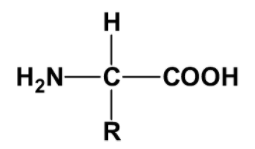
In the above general formula for an amino acid, the letter R stands for

a. Amino group
b. A carboxyl group
c. A variable group
d. A hydroxyl group

Answer
566.1k+ views
Hint: Amino acids have four substituent groups occupying four valency positions namely hydrogen, carboxyl group, amino group, and a variable group. Amino acids are organic compounds. They are called $\alpha $ -amino acids because they contain an amino group and an acidic group as substituents on the same carbon which is called the $\alpha $ -carbon.
Complete answer:
The variable group is designated as R. The R group in these amino groups could be hydrogen (then the amino acid is called Glycine), a methyl group (alanine), a hydroxymethyl group (serine), etc. The amino, carboxyl, and the R group determine the physical and chemical properties of amino acids.
Amino acids can be classified into seven types:
• Neutral amino acids have one amino group and one carboxylic group with a noncyclic hydrocarbon chain. For example Glycine
• Acidic amino acids have a carboxyl group as their functional group. For example Glutamic acid
• Basic amino acids have an extra amino group. For example Lysine.
• Sulphur containing amino acids contain sulphur. For example Cysteine
• Alcoholic amino acids have a hydroxyl group. For example Serine
• Aromatic amino acids have cyclic structures with a straight side chain. For example: Tryptophan
• Heterocyclic amino acids have nitrogen in the ring structure. For example: Histidine
Hence, the correct answer is option (C).
Additional information:
• Proline is the only $\beta $ - amino acid.
• There are many non-protein amino acids like $\gamma $ -amino butyric acid, ornithine.
Note: Peptides are formed by the condensation of amino acids. There are $20$ amino acids of which $10$ are essential amino acids and $10$ are non-essential amino acids. Amino acids are the building blocks of proteins and enzymes. Amino acids are left behind when proteins are digested or left behind.
Complete answer:
The variable group is designated as R. The R group in these amino groups could be hydrogen (then the amino acid is called Glycine), a methyl group (alanine), a hydroxymethyl group (serine), etc. The amino, carboxyl, and the R group determine the physical and chemical properties of amino acids.
Amino acids can be classified into seven types:
• Neutral amino acids have one amino group and one carboxylic group with a noncyclic hydrocarbon chain. For example Glycine
• Acidic amino acids have a carboxyl group as their functional group. For example Glutamic acid
• Basic amino acids have an extra amino group. For example Lysine.
• Sulphur containing amino acids contain sulphur. For example Cysteine
• Alcoholic amino acids have a hydroxyl group. For example Serine
• Aromatic amino acids have cyclic structures with a straight side chain. For example: Tryptophan
• Heterocyclic amino acids have nitrogen in the ring structure. For example: Histidine
Hence, the correct answer is option (C).
Additional information:
• Proline is the only $\beta $ - amino acid.
• There are many non-protein amino acids like $\gamma $ -amino butyric acid, ornithine.
Note: Peptides are formed by the condensation of amino acids. There are $20$ amino acids of which $10$ are essential amino acids and $10$ are non-essential amino acids. Amino acids are the building blocks of proteins and enzymes. Amino acids are left behind when proteins are digested or left behind.
Recently Updated Pages
The number of solutions in x in 02pi for which sqrt class 12 maths CBSE

Write any two methods of preparation of phenol Give class 12 chemistry CBSE

Differentiate between action potential and resting class 12 biology CBSE

Two plane mirrors arranged at right angles to each class 12 physics CBSE

Which of the following molecules is are chiral A I class 12 chemistry CBSE

Name different types of neurons and give one function class 12 biology CBSE

Trending doubts
Which are the Top 10 Largest Countries of the World?

What are the major means of transport Explain each class 12 social science CBSE

Draw a labelled sketch of the human eye class 12 physics CBSE

Differentiate between insitu conservation and exsitu class 12 biology CBSE

The computer jargonwwww stands for Aworld wide web class 12 physics CBSE

State the principle of an ac generator and explain class 12 physics CBSE




